Today we talk about the best composting toilets for clean, green living. Not everyone is into the whole “eco-friendly” thing, but it is hard to argue with how useful a composting toilet can be.
We wanted to really go in depth here, so consider this your comprehensive guide to composting toilets and related info.
Composting toilets are not only eco-friendly but more sanitary than sewage-creating toilet systems.
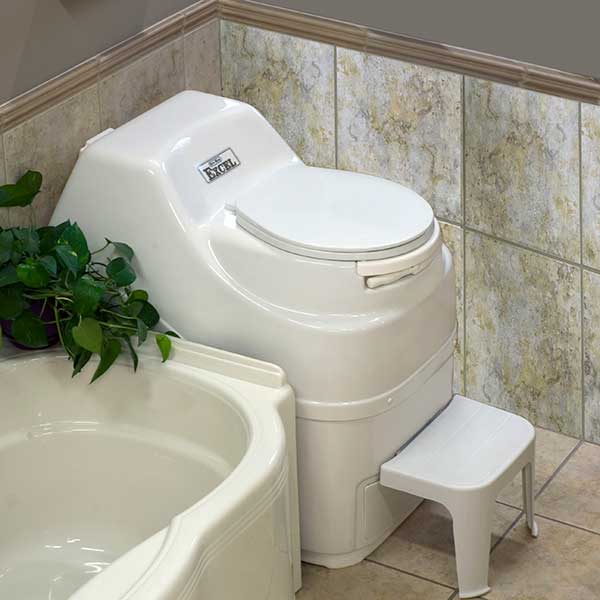
What's in this Guide?
And they are ideal for anyone who has a garden! The best composting toilets may ultimately save you both money and agricultural resources.
We have all been taught what’s called the “flush and forget” model of waste disposal. This is a two-part process: Flush and Forget.
The problem is that this system is very energy intensive and highly expensive to maintain on a large scale. Not to mention the problem of sewage-contaminated water and soil when the waste is eventually dumped.
Forget What You’ve Heard
Composting toilets have this bad rap – you mention them and people think of a reeking outhouse. This is completely off base though. Composting toilets actually smell less than regular toilets. Many of them even come close to completely eliminating odors. That in itself is a big deal, really. And they cost a fraction of what you get charged to install a septic system.
So it’s not just about saving the planet’s resources… Of course, green-earthers love these toilets for a reason. One very crafty person actually used his old desk as the frame for a composting toilet. Going this route is extra resourceful, but we hope that guy did not continue using it as a desk.
In this guide, we’ll be covering the best composting toilets, the composting process, toilet tactics, and plenty more. Good product info is like a good toilet: Without it, you may end up in deep… Well, you know.
Here is a List of the Best Composting Toilets
1. Villa 9215 AC/DC Compost Toilet
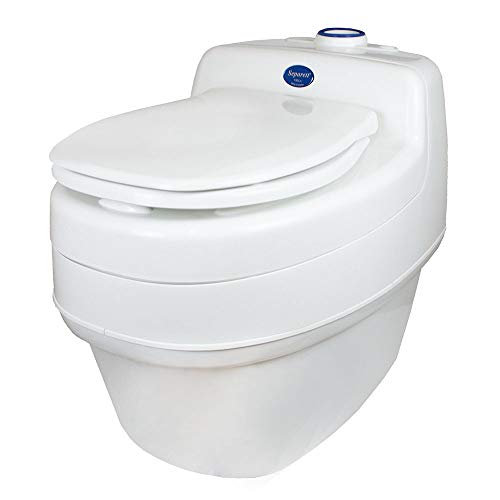
Price: Around $1000
My Review: This is an electric, urine-diverting option from Villa. The 9215 AC/DC is so named because you can power it with alternating current (on-the-grid homes) or DC (battery or solar power for off-the-grid homes).
It’s got a solid single-speed fan and can vent up to 20 feet, a comforting distance to be from the smell of poop. The fan has a guarantee of three years, which isn’t too bad. When you think about it, that’s rather a lot of toilet use just for a single person. There is also a five-year guarantee vs. manufacturing defects.
The 9215 can include a child seat if you like, but kids tend to have some difficulty using a urine-diverting system. The solid waste is contained in a holding area like normal, but the interior of that area is lined with a compostable bag. This makes it extra easy to remove when the time comes.
The vent actually serves a dual purpose of getting rid of the smell and using the air to help dry the waste for good composting. The composting only gets partway done though. Before it has been completed, the solid waste container is ready to be removed and the waste extracted.
This is the chief reason for the interior lining of the container, as you will be handling some waste that has not fully converted to soil.
However, with the lining bag, you don’t need to worry much about actually touching the waste. If you do it right, you shouldn’t have to touch anything unsanitary. Still, don’t forget your gloves.
Key Features:
- Can be powered with alternating current
- Includes a solid single speed fan
- Cant vent up to 20 feet
2. Nature’s Head Toilet
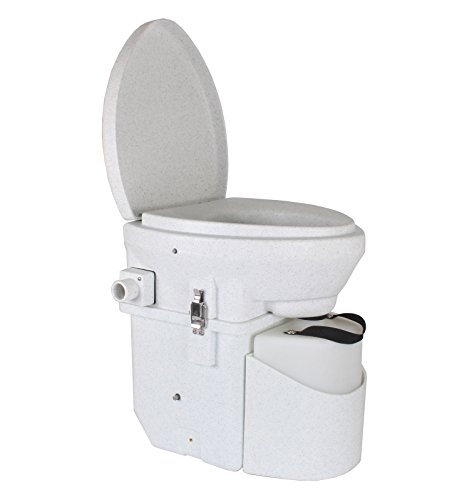
Price: Around $960
My Review: This is an entry from Nature’s Head, another reliable supplier of composting toilets. The self-contained spider-handle unit is built from stainless hardware with a large, elongated seat for maximum comfort. We hear most people enjoy being comfortable while pooping.
Composting toilets have been around for a little while, but this is a pretty modern design. It disassembles very easily when you need to empty it. The disassembly feature is also important for users on the go who need that portability.
Of course, you disassemble this thing and haul it somewhere, you make darn sure you scrub it clean first! We have included some of our favorite green cleaning supplies below.
The Nature’s Head actually got its name from the marine term for toilet: The “head.” As the story goes, two salty sailors wanted an accessible toilet product that could withstand the barnacle-tough bite of a marine setting. A sailor’s toilet, they thought, ought to be as tough as the sailor himself.
Thus, Nature’s Head was born, along with some of the best composting toilets around. This unit is practically guaranteed to serve wherever you need, from campers to yurts! But it claims to do more than provide a tough alternative to slightly wimpier composting toilets–it claims to eliminate foul odors beyond what other holding-tank toilets can do.
We can’t say there is an incredible difference, but in terms of odor, this unit is certainly no worse off than any of the other composting toilets on our list. And that’s a good thing for sure since none of these toilets smell a quarter as bad as a standard wet toilet. That is a big plus for us, by the way.
If you expect your outdoor experience will demand an extra-tough toilet with a serious level of durability, this is probably the one for you. Oh, and the price is nothing to complain about either. This bad boy is half the price of the comparable Sun-Mar unit.
Key Features:
- Composting toilet made in the USA
- Stainless steel hardware
- Vent hose and fan included
3. Sun-Mar Non-Electric Toilet
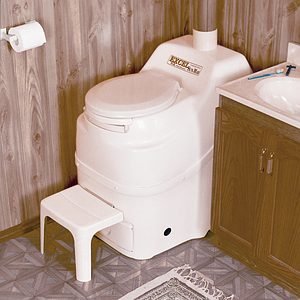
Price: Around $2200
My Review: This unit is nearly identical to the previous model described above. The major difference is that this one is–you guessed it–non-electric.
Portable, nearly odorless, dry, and designed for relatively frequent use, this is another good solid product from composting toilet champion Sun-Mar. The recommended usage is slightly lesser than its brother, the electric version. This one is ideal for two-to-three users in a single home or five-to-seven on a weekend getaway.
The major reason you’d select this one over the heavier-duty electric version is off-the-grid usage. For locations that are really backwoodsy, it’s gonna be an ordeal to locate an electric outlet. Instead of looking for one in the forest, bring a non-electric composting toilet like this one.
There are a few negative reviews that describe a “fecal soup” leaking from the unit when supposedly installed properly. We can tell you that if you have a basic understanding of composting and how these toilets work, you will likely not run into any such issue.
Composting toilets require some smart investing, which is to say, do your research! Even the best composting toilets will become sewage hubs if you don’t use them properly. A lifetime of wet toilet usage makes our classic porcelain units easy to grasp, but if you used one for the first time without proper education, you might be pretty confused when the toilet overflows.
Psst–don’t empty an entire roll of toilet paper into a wet toilet and then pull the flush handle!
Key Features:
- This model is non-electric
- non-polluting
- No water required
4. Sun-Mar Excel Self-Contained Toilet
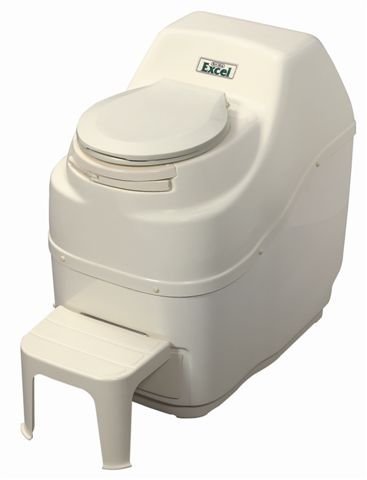
Price: Around $1750
My Review: Sun-Mar is a pretty big name in the world of composting. That being the case, we weren’t surprised to discover that the Excel is one of the best composting toilets available. This is one of their “self-contained” models, or in other words, portable.
As advertised, this unit does an excellent job of odorless waste conversion, but it is also designed for heavy use–sort of an unusual feature in a portable composting toilet. It can be used as the sole outlet for approximately four people in a single residence. Alternatively, for a vacation setting, it could serve up to eight people over a weekend.
It is advertised as being “pest-proof,” although it is not clear exactly how this is the case. Most composting toilets don’t attract bugs anyway (with the exception of the fungus gnat in areas where it thrives), so this isn’t a hugely noteworthy feature.
It’s got a detachable footrest, which is pretty sweet–no reason not to relax a little while you do your thing. Footrests aren’t merely for comfort though–they serve the additional purpose of conforming your posture to the classic squat of our distant ancestors.
Back in the day, before toilet systems, solid waste was not dispensed while sitting on a chair! Our forefathers had to squat down, creating a body shape that is importantly different than what modern toilets have us all used to. A footrest helps to elevate the feet, simulating a squat and easing the exit of waste from your body.
There’s also an emergency drain included with this unit for those instances where you end up with a seriously dysfunctional waste container.
The cons? Some users have trouble with the crank handle for turning over the compost/waste mixture. It can apparently break fairly easily, which is not a plus when you are shelling out serious dough for a composting toilet.
Overall, this is a great portable unit, totally dry, and easily mobile for all your traveling needs. Watch that crank though.
Key Features:
- Low profile design
- No water required
- Get for cabins, residences, or commercial applications
Other Items for Composters and the Green Lifestyle
The best composting toilets are at the top of their game when paired with other green products. Here is a list of some of our favorite cleaning items and personal protective equipment!
5. Aria Premium Earth-Friendly Toilet Paper
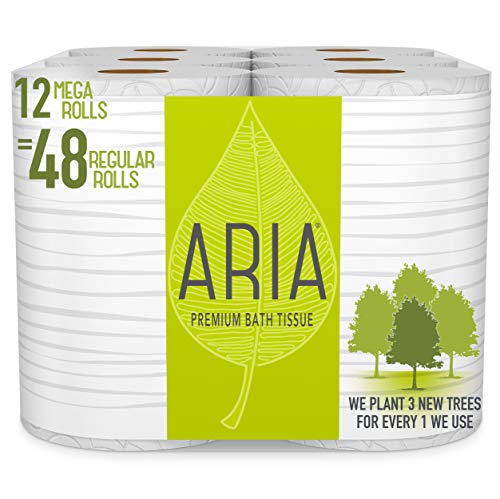
Price: Around $20
My Review: This is a strong, yet soft paper material. Its thick two-ply density proves that strength doesn’t mean sacrificing comfort. According to the retailers, this paper is “50% thicker and 3x stronger than the leading recycling brand.”
Well, we can’t say for sure whether that’s true, mainly since they don’t clarify just what that leading brand is! That said, this is the good stuff. Soft, durable, and totally renewable. It even comes in plant-based packaging! They went full green with this toilet paper.
Aria says it is “committed to sustainable forestry,” and to that end, it will plant three fresh trees for every tree that it uses to create its product. That’s commitment, folks. You ever tried to plant a tree? It’s work. Kudos to Aria on that count.
The paper is unscented, so sensitive customers and users with allergies don’t need to worry about unpleasant odors (from the toilet paper anyway). This version of the product comes with 12 “mega rolls,” which are equivalent to 48 normal ones. That’s a lot of toilet paper!
The eco-friendly mindset is sort of infectious–you start thinking about one way of contributing to the environment, and it starts to creep into other aspects of your life. You probably haven’t given a ton of thought to the impact of your TP.
That’s okay, we didn’t either. But with how precious our planet is, even the little things are important. Buying biodegradable toilet paper from a company that more than replenishes the trees it uses? Pretty awesome.
Not to mention the impact of trees on our environment–they actually reduce carbon dioxide and other pollutants. Not bad, eh? And for how much paper you get, this stuff isn’t badly priced at all. Hard to find the downsides here, and believe us, we looked.
Key Features:
- Strong 2 ply toilet paper
- Perfect for composting toilets
- Aria plants 3 trees for every tree used to make this product
6. Cottonelle Ultra Comfort Care Toilet Paper
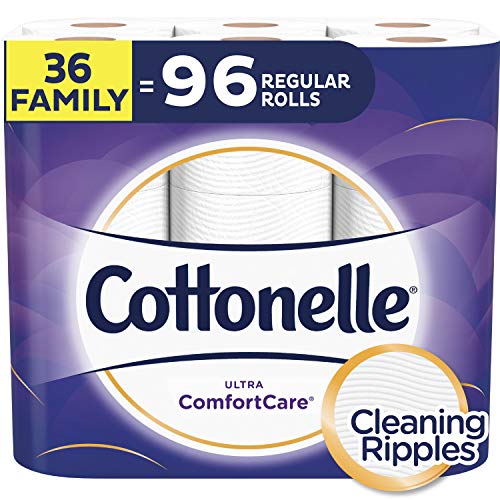
Price: Around $22
My Review: Here’s another option in biodegradable toilet paper. It is not only soft but supposedly “removes more at once” than the leading brand. Who are these leading brands anyway? By “removes more,” we guess they mean poop. Not certain about that, but it certainly does an acceptable job.
It did appear to be slightly more absorbent than the competition, so that could be a deciding factor for prospective buyers. Cottonelle’s Ultra Comfort toilet paper is supposed to be 3x thicker, stronger, and more absorbent than other brands.
It was certainly durable and thick, so no real disagreement there. Probably thicker and a bit cushier than the Aria brand above.
This stuff is also totally compostable, so no worries about trashing the environment if you happen to leave it in the woods. The packaging isn’t biodegradable as far as we can tell, so that might be a minor concern for some.
Some of the proceeds from this product end up contributing to the conservation of forests–450 million acres of forests around the world, to be exact. The main contrast between this and the Aria product boils down to company conduct.
Is it better to plant new trees at a set rate or protect and conserve huge forested areas? We’ll leave it up to you to decide. This and the Aria paper are both totally green and functional options.
Key Features:
- Soft biodegradable bath tissue
- Very comfortable
- Very soft 2-play toilet paper
7. Naturally It’s Clean Toilet Bowl Cleaner
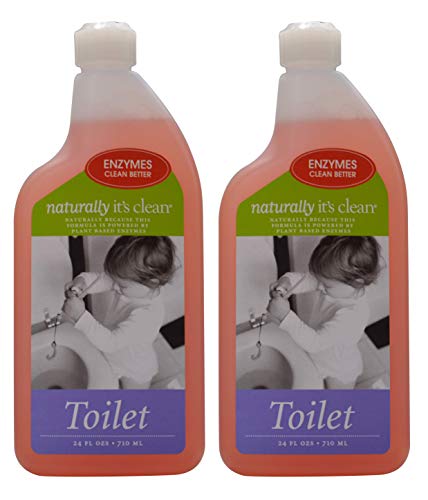
Price: Around $18
My Review: This is our favorite option in green toilet bowl cleaners. Made from plant enzymes, it’s biodegradable, pH neutral, and there is no animal testing involved in the process. It’s not one of those questionable chemical cleaners normally used for heavy-duty bathroom cleaning.
Even if you’re not Mr. or Mrs. Green, families and pet owners often look for cleaning solutions that don’t create dangerous environments for animals and little ones.
This is also an odor eliminator. It doesn’t cover up odors with a chemical smell though. It actually breaks down the organic substances in toilets that cause odors in the first place. Given that most composting toilets don’t actually produce excess odors, this is one way to make sure your bathroom area smells nice and fresh.
You can use this good stuff on other surfaces too, so it’s not limited to toilets. Shake it up, spray it, scrub the area, and you’re good to go. For those of us who dislike chemical scents like that artificial lemon odor, this is a perfect alternative. It only has a very light, natural scent of lemon–not that harsh chemical funk.
This is one we recommend pretty strongly, though it doesn’t always do an amazing job getting rid of stains. It’s better used as a way to keep things generally fresh. Just spritz it and briefly scrub your composting toilet a couple of times per week. Easy peasy.
Key Features:
- Awesome odor eliminator
- Made in the USA
- Easy to use
8. Wells Lamont Chemical Resistant Gloves
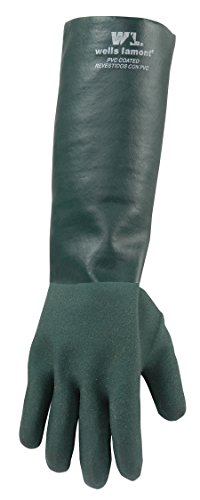
Price: Around $11
My Review: Okay, so you will find yourself dealing with a little waste or a bunch of compost as you use a composting toilet. Even the best composting toilets don’t guarantee that you never have to get your hands dirty.
Given the environmental trade-off and the odorless nature of most composting toilets, we think this is completely fair. However, for those situations where you’ll need to empty a waste or compost container, we prefer the Wells Lamont gloves.
These things are suited for strong chemical exposure, which is generally worse than anything you’ll need to manage with a composting toilet. But all the same, we wanted something strong and protective. With these gloves, we got it.
They’re PVC coated with a textured grip for excellent handling, and the gauntlet cuff extends up the arm to protect wrists and forearms. Some users prefer disposable rubber gloves from a box, and while these are not a bad option, they don’t provide comprehensive coverage of the Wells Lamont gloves.
Plus, have you ever been strapping on those disposable ones and found that they ripped? Worse yet, have you discovered the tear after touching waste? No thanks.
These gloves are not going to rip, that’s for sure. Their heavyweight structure and 18” coverage make them perfect for the occasional maintenance of your composting toilet. They’ll even protect you from most acids! If there is acid in your poop, though, you should see a doctor.
Key Features:
- 18 inches long
- Awesome multipurpose gloves
- PVC coated with texture grip
Ultimate Composting Toilet Buying Guide
What the Heck is Compost?
The word “compost” gets thrown around a lot, but what is it? Basically, compost is organic material that is rotting into that dark brown soil-type stuff.
You can create compost from kitchen scraps like banana peels, shredded plant life, or similar materials. Composting is an important process because it recycles organic substances that are usually thrown away. In fact, it is sometimes referred to as “black gold” for its sheer power to enrich growing plants. You probably won’t find any in a bank vault though.
Composting ultimately conditions the soil, which allows plant life to flourish. Nutrient-rich compost is heavily used in every plant-growing effort, from farming to urban agriculture. Compost can even work as a natural pesticide against certain insects!
In a nutshell, compost contains various bacteria and fungi. These interact with plant roots beneath the ground. With compost, the roots essentially have an easier time pulling nutrition from the soil. We often think of bacteria as enemies to health, but all life on Earth is teeming with bacteria.
Good bacteria, bad bacteria, ugly bacteria… Earth’s life depends on it, though this does not mean you should cozy up to a dirty bathroom floor.
Compost is virtually identical to fresh soil. It also helps plantlife by:
Enhancing soil structure
Improving aeration
Increasing how much water plants can hold
Releasing nutrients directly to plants
As it degrades, you call it compost. Once the compost completes its rotting process, it is then made mostly of “humus.” Humus is the dark dirt-looking stuff. Humus may sound like a Greek snack, but we recommend that you do not dip a chip in it.
So how do you get a hold of this good stuff? You can always buy compost in bags, but why not save a little money and go the homemade route? One of the easiest ingredients you can use to make compost is your own renewable supply of human stool!
You can’t discuss the best composting toilets without a little poop science, so here we go. The best composting toilets take your solid waste and turn it into biodegradable matter. Instead of adding to the horrifying blend of human waste that lurks in the sewer, you can dispose of composted waste outdoors. Composting toilets are sometimes called “ecosan” toilets, short for ecologically sanitary.
The safe reuse of human waste is one way to keep the planet clean, and most people are happy to keep poop levels to a minimum. Instead of simply discarding it in the woods somewhere, you can apply compost to your garden–or even sell it! And they said your number-twos would never amount to anything.
How Do Composting Toilets Work?
A composting toilet is basically a unit for waste disposal like any other toilet. But unlike septic tank/sewer system toilets, composting toilets change human excrement into compost.
They do this using carbon materials like peat moss or coconut coir, which mix with the waste and allow it to decompose properly. The waste that goes into the toilet is made up mostly of water. That fluid is removed in a couple of different ways. It can:
Evaporate by venting out of the composting toilet. The solids left behind decompose in drier conditions, changing into compost.
Store in a separate container (in the case of a urine-diverting toilet)
By the time you empty your composting toilet, it’s not really poop anymore. It’s a rich dark soil-type material called “humus.” Easy to extract, safe to handle. You can empty the final product right into a new container and do with it what you will.
What Comes in a Composting Toilet?
In a composting toilet system you’ll find:
A storage unit for the waste to sit in.
This is where your waste will eventually turn into compost.
If your toilet is portable, it will be a small unit. If you have a larger, central composting toilet system, it will be a big container that sits in the basement or outside the home.
A venting system for the evaporation of liquids.
This keeps the compost nice and dry, helping the whole process along.
If the storage area becomes too moist, it can interfere with the decomposition process.
Worse yet, harmful bacteria can thrive in waste that gets too wet. Lovely.
The vent also helps to get rid of bad odors and gases. The resulting compost is only just moist enough and ready to be dispersed.
A separate container for urine, which is diverted from solid waste when you use the toilet sitting down (and you really should use it sitting down).
An access panel of some kind you can open to extract the compost.
It is very common for composting toilets not to flush. They are often “dry toilets,” so they don’t use more than a little flushing water at most. Many are actually completely water free.
This can be a little confusing, as urine-diverting toilets do a similar thing by separating solids from liquids. As a result, they are sometimes referred to as dry toilets, but this is a misnomer.
Virtually all composting toilets use some kind of additive material to mix into the waste. This begins the composting process and ultimately leaves users with a clean, sanitary, and non-smelly product. Peat moss, coconut coir, and sawdust are all common additives that can be used to mix in with the solid waste.
Basically, these additives create tiny air pockets inside the fecal matter. This causes a process called “aerobic decomposition.” This is pretty much where oxygen allows tiny living organisms to feast on the waste. The result is a nice, dry-ish clump of compost.
Why Use a Composting Toilet?
The real question is, why not?
With no connection to a septic tank or sewer system, composting toilets can be portable and easy to manage. The portable variants are usually self-sufficient units perfect for vacations, military use, or any kind of on-the-go lifestyle. Anytime you’re moving around the country or distant from civilization, a portable composting toilet is a great choice.
But even the fixed composting toilets are a pleasure to use. National parks, off-the-grid homes, and developing areas are all perfect settings for the use of a fixed-station composting toilet. Sewage issues are pretty much nobody’s favorite, and a composting toilet can avert these issues in the first place.
Septic systems are also expensive, let’s not forget about that. If you are determined to build a home off the grid, but you’re working with a budget, a composting toilet of either kind can do you right.
Types of Composting Toilets
Not all toilets are created equal. A quick Google search for the best composting toilets will reveal a wealth of info on this subject.
It is, in a word, confusing. There are so many different composting toilet features and subtypes that the info mixes into a muddled brown mass. Hey, that sounds familiar. During this dense and frustrating research process, there are a lot of questions. For example, are the best composting toilets:
Portable?
Central?
Dry?
Urine-diverting?
Moldering?
Internal?
Are any of these categories mutually exclusive? Which features necessarily go together? It’s a madhouse! Fortunately for you, readers, we have sorted through this mess. You are welcome.
By our reckoning, there are two main types of composting toilets: Central and portable. Beyond that, there are two important subtypes: Urine-diverting systems and internal systems.
If you have decided to purchase a composting toilet, be sure you know which type you’re getting! Which is to say, if you don’t know what it is, don’t poop in it.Types
Central Composting Toilets
Some of the best composting toilets are central composters. In fact, most composting toilets follow this model.
Central composting toilets are installed in homes or other housing units, and they connect to a central unit located below or outside the housing structure. Every time you use a central composting toilet, you are adding to that long-developing pile of sweet recyclable goodies.
Multiple central composting toilets can be hooked up to the same receptacles, and they can be either urine-diverting or internal.
Portable Composting Toilets
Sometimes known as “self-contained” composting toilets, these bad boys do much the same as their slow cousins. That is, they compost waste inside a toilet compartment. The chief difference is that they can be lugged around!
Portable composting toilets are perfect for off-the-grid living, camping trips, remote lake cabins, or any operation taking you into nature. They are also required for entry into any respectable BYOT party: Bring your own toilet. Don’t leave home without it!
Subtypes
Urine-Diverting Toilets
These toilets have a series of holes toward the front of the toilet bowl. The holes are used to collect urine, which is diverted to a container separate from the solid waste. Sometimes there is a lever you can use to cover the solids hole when you only intend to urinate.
This prevents unnecessary liquids from entering the solids compartment. In any case, a urine-diverting toilet cuts way down on the maintenance factor. This is because an internal system (where solids and liquids travel to the same container) requires careful management of solid-to-liquid ratios.
Too much urine in the feces tank and you don’t get compost–you get a heaping helping of soggy sewage. Merry Christmas.
Internal Composting Toilets
As mentioned, internal systems don’t separate liquids and solids. It’s one big party down there, and everyone’s invited.
These toilets manage the excess moisture issues with heavy venting and an emphasis on evaporation. They are an older model than the urine-diverting types, and they require some care. You don’t want the moisture levels getting too high, or it’s sewage city.
The upshot is that you will not have to deal with a urine tank, which tends to require more maintenance than the solids (it fills up faster). Also, the compost you produce will be more nutrient-rich, due mainly to urine’s phosphorus content.
The Best Composting Toilets: Other Important Terms
The above two types and two subtypes represent the bulk of what you need to know. As you dig into your search for the best composting toilets, here are some other terms you will encounter:
Electric: This is what it sounds like. Electric composting toilets use a modest amount of energy. Typically, this is to power the venting system and expel foul odors to somewhere you cannot smell them.
Dry: A toilet that uses little-to-no water is called a dry toilet. Do not confuse this with a dry martini.
Slow: The slow composting process is reserved for central composting toilets. It means that the waste composts very slowly over a long stretch of time. Larger storage containers are best suited to this process. The result is a container that rarely needs to be emptied and renewed. The long stretch of time also helps to ensure the elimination of waste-based pathogens.
So They Really Don’t Smell?
No, unless you hate the smell of soil. As you dispose of the actual compost/humus material, the main odor you’ll sniff is that of dirt or other soil-like materials. Of course, as you defecate, it will smell about as good as it usually does.
The difference is that the vent in a composting toilet actually vacuums the air straight out of the bowl. It does this constantly. The end result is a significantly less odorous pooping process, and a bathroom that smells maybe a tenth as bad as the average offenders.
The vent creates a mild humming noise that is about as loud as a refrigerator unit. Not bad, unless you have one of those evil old fridges that clanks and groans through the night.
Frequently Asked Questions
You have questions, we’ve got answers. And if you think we haven’t thought of every major question, you’re full of it.
Q: When do I need to dump the compost?
A: This depends on the specific composting toilet and how many people are using it. A portable urine-diverting composting toilet will usually need to be emptied of solids every three-to-four weeks. Liquids will need to be dumped every three-to-four days.
On the other hand, a central composting toilet may take approximately 150 days to fill up.
Q: What’s so great about human poop anyhow?
A: The average human’s solid waste contains materials like nitrogen, phosphorus, potassium, and other good organic stuff. This is like fine dining to plants. You can grow a respectable garden in short order with compost/humus materials.
Also, unless you love filling up reservoirs with sewage, there is a very good reason to get rid of poop by transforming it into a new, inoffensive substance.
Q: If I eat a tomato from a plant that grew up on my compost, am I somehow eating my own waste?
A: The physical, scientific answer is no. We’ll leave the symbolic answer up to you.
Q: Do composting toilets attract bugs?
A: There is one main bug that is attracted to rapidly moldering compost: The fungus gnat! This little guy wants to get friendly with nice, dry compost. Keep the moisture levels around 40-60% in the compost container. This will make it less attractive to fungus gnats looking for a good time. Other than that, keep the unit sealed when not in use.
Q: Are composting toilets sanitary?
A: The short answer is yes. This one gets a little scientific though. So in a normal toilet, fecal matter mixes with water. This is an ideal breeding ground for dangerous bacteria. The key is to dry the feces out, which is exactly what composting does.
If someone has recently used the composting toilet, it may have active bacteria on it–but no more than your average toilet. In fact, public bathrooms are way more dangerous. The toilet handles and the sinks are the nastiest parts: They get touched by lots of hands, and in the case of the sinks, they are wet.
Many composting toilets actually keep solids separate from liquids, (urine diverting) and most are dry, (no flushing water) making composting toilets more sanitary to use than your average toilet.
Q: Does waste continue to compost after you remove it from the toilet?
A: Just you try and stop it! That waste is gonna compost all night long if you catch our drift. But yes, the composting process can continue even after you put the waste into a new container. If you use a compostable bag, this can make disposal extra simple. You won’t have to remove the waste from the bag.
Q: Should I put a composting bag in a portable toilet?
A: You can, but it might prove tricky to remove. It’s usually easier to just wrap a bag around the toilet/compost container and upend the contents into the bag.
Sometimes there is a bit of soil leftover after “dumping”… That’s okay! You can just leave it there and pile more new soil on top.
Q: Where do I dispose of my compost?
A: A couple of different answers here. For one, there are special compost bins you can buy. You can sign up for a local retrieval program that collects compost and puts it to good use.
Secondly, if your local laws allow, you can just sprinkle or bury your compost in certain areas. And don’t forget to use it in your garden!
Q: What do I do with toilet paper when I use my composting toilet?
A: You can usually just put it in the toilet! Double-check with the manufacturer of your particular make & model if you use regular toilet paper.
One simple option is to use compostable toilet paper. Let it degrade in the compost pile. If you’re going to go green, go full green. If you want.
Q: Do I have to sit down when I pee in a urine-diverting toilet??
A: Well we won’t make you, but it’s far and away the best option. Most compostable toilets have liquid tanks that catch urine. There will be a few holes in the front of the bowl where you can easily aim your liquids. This keeps them separate from the solid waste, allowing safe composting to happen.
Gentlemen, if you opt to stand while urinating into a compostable toilet, you may need to aim with care. Make sure to aim it into the section of the toilet that catches urine. Due to splatter, this is probably the less sanitary option overall.
We won’t tell anyone if you sit while peeing, guys.
Q: Can we talk about diarrhea?
A: We would love to! If you have frequently irritable bowels or other issues that lead to diarrhea, a urine-diverting composting toilet may not be for you.
The urine-diverting toilet depends on drier conditions, and the moisture of diarrhea can mess with that. It won’t be the end of the world if this happens every so often. But if you know this is a recurring issue, it could prove problematic. There is always Pepto-Bismol.
The Best Composting Toilets: Flushing it All Down
Now that’s a lot of info to take in! Make sure that as you investigate the best composting toilets, you have our handy guide at the ready. Just to refresh, let’s run through everything we covered here.
Composting
When human waste is combined with certain materials like peat moss and leftover time, it composts. This is a process of decay that results in a dark, dirt-smelling soil called humus. Plants love it.
Composting Toilets: How Do They Work?
The waste is mixed with certain additives in a storage container attached to the toilet. The composting process works on its own with very little interference from you. When it’s ready, you remove the compost and allow it to return to nature. Forget the sewage system–Let Mother Earth do the work for you.
Why A Composting Toilet?
Composting toilets provide a series of benefits:
- Less expensive to install than a septic/sewer system. Like, way less expensive.
- Better for the environment
- If managed properly, more sanitary than wet/sewer/septic toilets
- Smell? What smell?
- Who Should be Interested in the Best Composting Toilets?
- Anyone who:
- Travels in an RV
- Operates a nature reserve or national park
- Manages the living necessities of military-style operations or construction work in remote areas
- Lives off the grid.
Composting Toilets: Types and Subtypes
The two main types of composting toilets are:
- Central-System Toilets
- Portable Toilets
Centrals feed into a large storage area under the bathroom or outside the home. Portables are, well, portable! You can take ‘em anywhere you like. Don’t take them with you on a date though.
The two subtypes are:
- Urine-Diverting
- Internal
Urine-diverting toilets keep solids and liquids separate for nice dry compost. They operate using a two-tank system. Internal toilets mix it all together and try to vent most of the moisture out.
The Best Composting Toilets Are Not Like Outhouses
Seriously, they aren’t. They don’t reek, they aren’t filthy, and they don’t compel you to look against your will into a nihilistic pit of brown despair. Where sewer system toilets encourage you to “flush and forget,” outhouses and their sour Honey Bucket cousins can be summed up by the reverse: “You cannot flush and you’ll never forget.”
Happy Composting!
Good luck to all you green-Earthers and composting enthusiasts out there! Even those who are just curious ought to dive in and do some investigating. The best composting toilets offer a waste disposal experience that is both smart and accessible.
If nothing else, you can take away this much: The best composting toilets are cheaper and smell way better than standard wet toilets. Personally, we’re sold.

Hello, my name is Chris and I was born and raised in Western Pennsylvania. I’m an engineer with experience in medical technology, steel and materials, and nuclear power industries. I have been with my current employer for more than 5 years developing digital control systems for nuclear power plants.
I’m also a homeowner with a growing range of home renovation experience. My goal is to take all my technical knowledge and first-hand experience and translate it into high-quality content to support all of your home guide needs. Whether it be step-by-step guides, technical consultation, or product reviews, my aim is to make all your home projects a great success!
